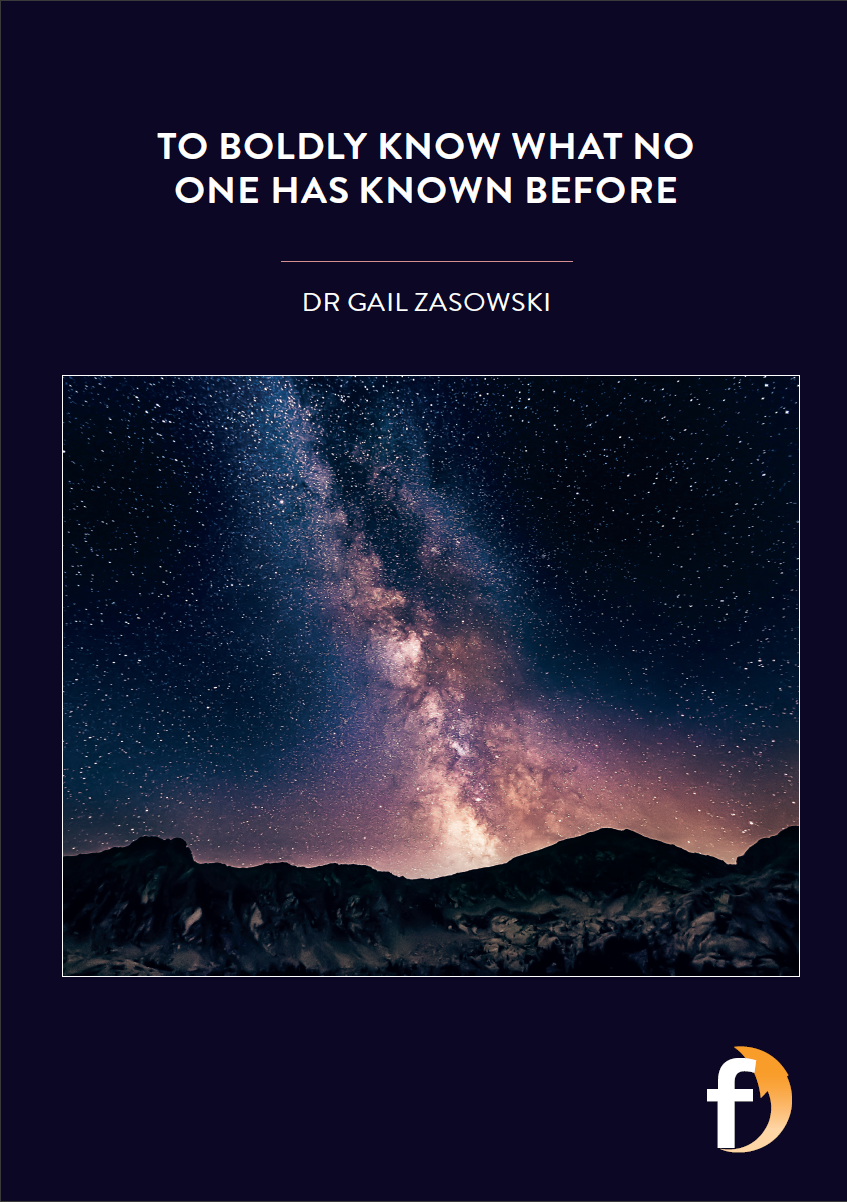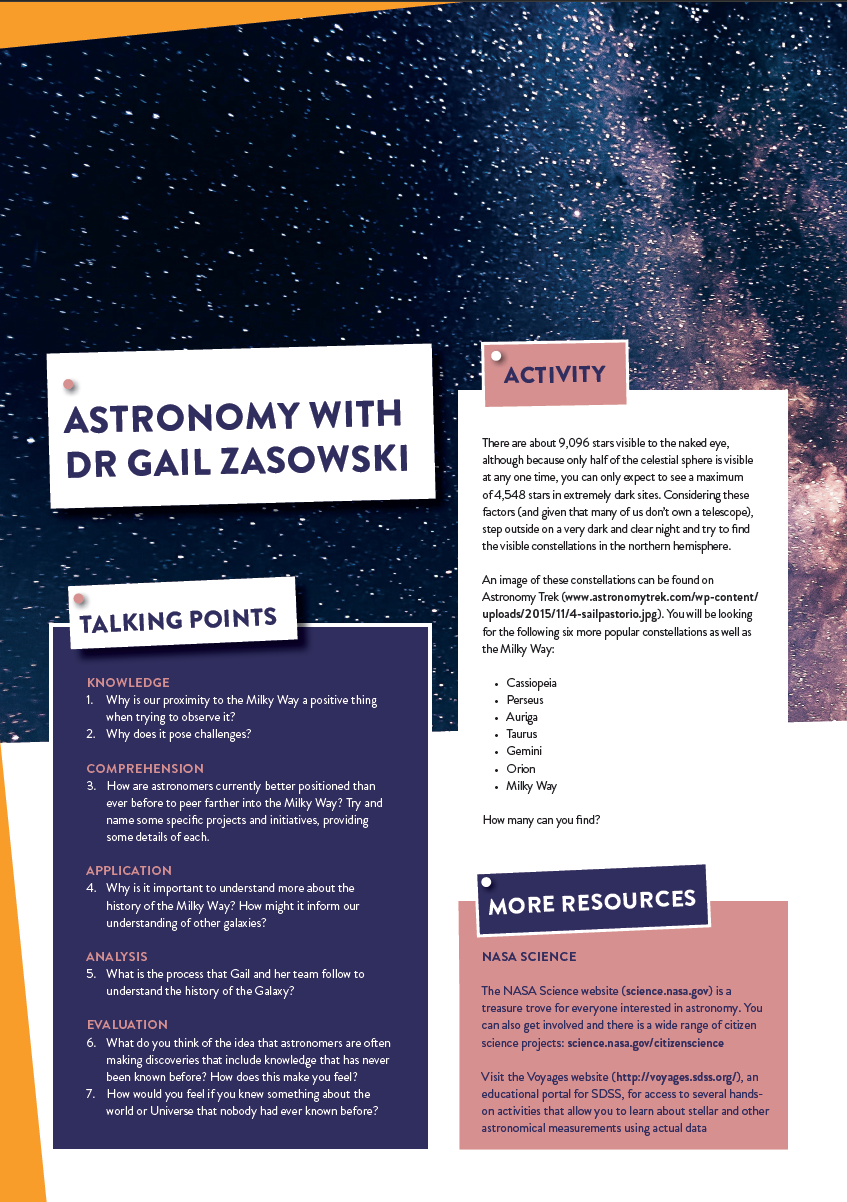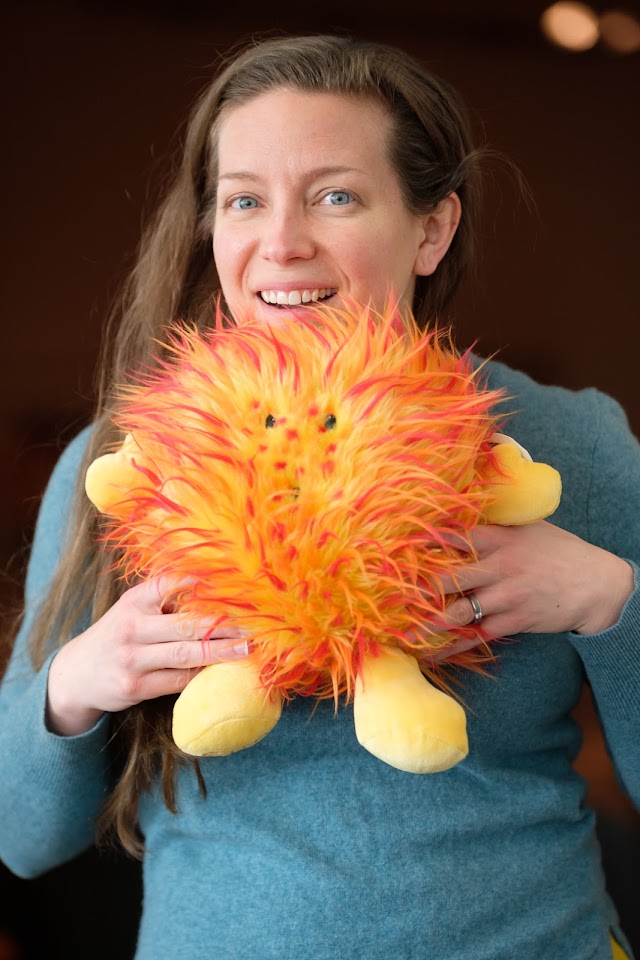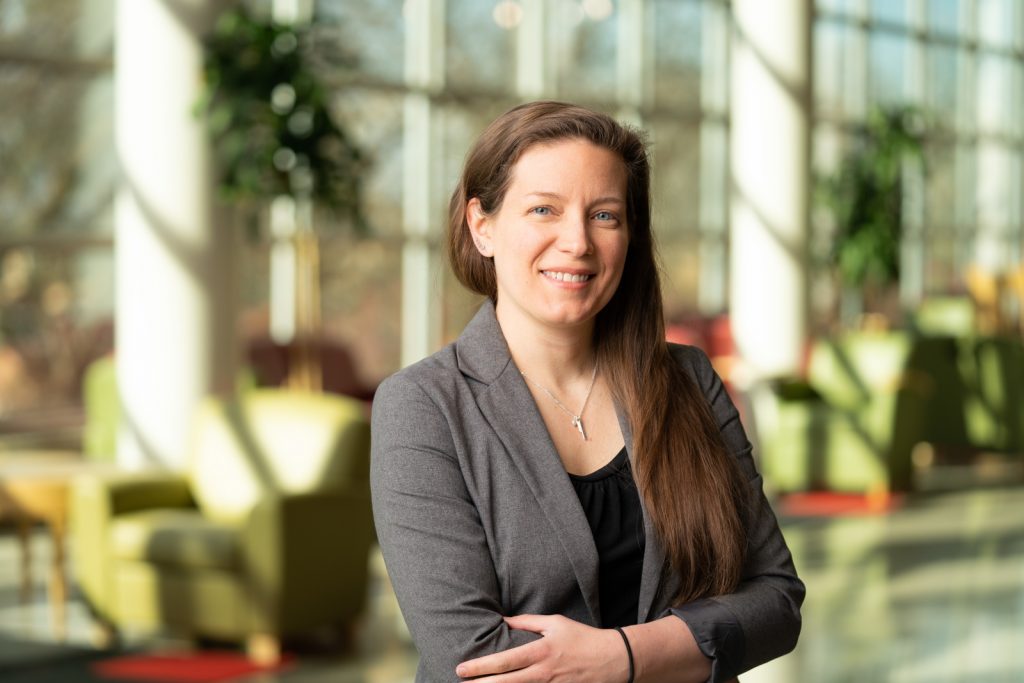To boldly know what no one has known before
THE BIG BANG – prevailing cosmological model explaining the existence of the observable Universe, from the earliest known periods through its subsequent large-scale evolution
GALAXY – gravitationally bound system of stars, stellar remnants, interstellar gas, dust and dark matter
GALAXY EVOLUTION – the physical changes and mechanisms that led to present-day galaxies
STARS – massive self-luminous celestial bodies of gas that shine by radiation derived from their internal energy sources
According to Captain James Kirk, space is the final frontier (although oceanographers might have something to say about that). Beyond the Earth’s atmosphere, there is a vast area of the Universe that we will likely never completely understand, despite the best efforts of mathematicians, physicists and astronomers.
However, rather than being a source of frustration, space represents infinite possibility, which is why astronomers like Dr Gail Zasowski, based at the University of Utah in the US, enjoy what they do in their professional lives. Gail is an astronomer with a particular interest in understanding where and when our Milky Way galaxy formed its 100 billion stars. Her research will help us understand how the infant Milky Way grew into the massive spiral galaxy that we see today.
WHAT ARE OUR CURRENT LIMITATIONS REGARDING UNDERSTANDING THE HISTORY OF OUR GALAXY?
Ironically, the main limitation to our understanding is closely related to the main advantage: that we are embedded inside the Galaxy. It can be thought of as the difference between looking at a map of a city and standing on a street in that city. “Looking at a map is like looking at other galaxies – we can see the overall shape and structure, where the business and residential areas are, and so on,” explains Gail. “But standing in that city has historically been like studying the Milky Way – we can’t see the pattern of streets or what the next neighbourhood looks like, but we can see the people and the shop windows, smell the smells, hear the sounds.”
However, in recent years, astronomers have been able to peer farther into the Milky Way than ever before. A lot of the difficulty in observing our galaxy is because of the thick clouds of gas and dust that fill the disc part of the Milky Way and block the starlight behind them. But some surveys, including the second generation of the Apache Point Observatory Galactic Evolution Experiment in the Sloan Digital Sky Survey III and IV projects, use infrared light to study the stars, which are much less affected by the intervening dust. The problem of perspective still exists, but astronomers are getting closer to being able to characterise the Milky Way in the same way as external galaxies.
WHY IS THE MILKY WAY SO IMPORTANT?
We can observe the Milky Way at a higher resolution than other galaxies because of our proximity to it. Although there are some challenges as previously noted, we can observe the small-scale building blocks of galaxies, such as individual stars and small gas clouds. “These observations have shaped our understanding of a large fraction of astrophysics, from what happens in the interiors of stars to the ways a whole galaxy can change over billions of years,” says Gail. “We then apply this understanding to interpret our observations of other galaxies – where we can’t see things at the same level of detail – and create a picture of how galaxies in the Universe, and the Universe itself, have evolved since shortly after the Big Bang.”
The ’big-picture’ questions Gail and her team are trying to answer include: “Where and when did the Milky Way’s stars form?”, “What are the main sources of heavy elements in today’s Milky Way stars, and when and how were they synthesised?” and “What is the best way to apply what we learn in our Galaxy to understanding what happens in other galaxies?”
Addressing these questions involves answering smaller ones, like: “How old are the stars in a specific part of the Milky Way and what is their chemical makeup?”, “What series of evolutionary events could give us this pattern of stellar ages and chemistry?”, and “How does the gas and dust between the stars move around throughout these events?”
METHODS, FINDINGS AND SUCCESSES
To uncover what elements are in a star, Gail and her team are part of a larger team that measures the star’s light at different wavelengths. Atoms of different elements absorb that light at different wavelengths, so models are fitted to the pattern of absorption compared with wavelength to determine how much of each element is present in the star. These same models also account for the star’s temperature, surface gravity and other properties that are necessary for computing distances and ages.
Gail’s group has worked hard to link detailed measurements that can be made in the Milky Way with global measurements that can be made in other galaxies (which are less detailed but cover a higher number of galaxies in different environments with different histories). “It has been very exciting to see many different analyses on stars in different parts of the Milky Way come together in a comprehensive picture of where and when its stars formed, including the influence of gas accretion events billions of years ago, which strongly affected the regions near the Sun (but which probably happened before the Sun formed!),” explains Gail.
“It has also been extremely gratifying to see the students and post-doctoral researchers in my group taking ownership of their work and leading their own projects, often collaborating with each other and with very little input from me. I value the success of the scientific work for increasing our understanding of the Universe and for launching the careers (in and out of academia) of so many hard-working scientists.”
WHAT ARE THE LONG-TERM PLANS FOR GAIL’S RESEARCH?
Many of the upcoming datasets – including for the SDSS-V, the next data releases from ESA’s Gaia mission and NASA’s Roman Space Telescope – will provide ever-larger troves of measurements of the stars in our Milky Way and nearby galaxies. “I am excited to work on recreating the history of our galaxy – playing the movie of its life, backwards – by mapping out where and when the stars form, how they release their new elements back into the galaxy and how those new elements move around between the stars before being incorporated into the next stellar generations,” says Gail. “I love learning things that no one has ever known before.”
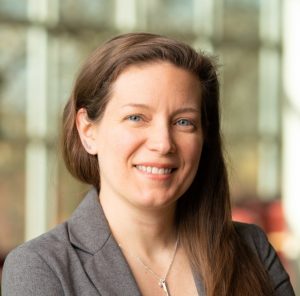 DR GAIL ZASOWSKI
DR GAIL ZASOWSKIDepartment of Physics and Astronomy
University of Utah, Salt Lake City, USA
FIELD OF RESEARCH
Astronomy and Astrophysics
RESEARCH PROJECT
Understanding where and when the Milky Way galaxy formed its 100 billion stars and how the infant Milky Way grew into the massive spiral galaxy we see today
FUNDERS
US National Science Foundation (NSF)
Research Corporation for Science Advancement
Heising-Simons Foundation
Astronomy is something that surely interests all of us to some degree and is a field that is ready for new discoveries. Only around 400 years ago, Galileo was chastised for championing Copernican heliocentrism (the belief that the Earth revolved around the Sun). This demonstrates just how ready the field of astronomy is when it comes to new and novel ideas that could fundamentally change our understanding of the ways things are.
Reference
https://doi.org/10.33424/FUTURUM284
Perhaps unsurprisingly, Gail loves learning things that no one has ever known before, such as seeing a particular pattern or correlation for the first time. In many ways, astronomy is not centred on answering questions, but on asking questions that no one has thought to ask before. “What I find particularly rewarding is getting to learn all these things about some of the biggest, most beautiful and most unfathomable objects in the Universe,” explains Gail.
“By ‘unfathomable’ I don’t mean un-understandable, but rather that we can’t truly picture their size, we can’t hold something that big or that hot or that old in our minds. Even stars, which we see every night with our eyes, and which are on average rather small and cool compared to other things in the Universe – our brains just aren’t set up to imagine those regimes.”
WHAT CHALLENGES WILL THE NEXT GENERATION OF ASTRONOMERS FACE?
There are always technical challenges: think about the difficulties of studying space without a telescope! Then think about the first telescopes and how primitive they were. Now think about the telescopes that we have presently and consider how they will one day be seen as primitive! It is a basic fact that we will be able to understand more about space with time simply because of access to improved and better tools.
But then, there are also data challenges. “Our datasets, observational and simulated, are getting increasingly larger, and being able to store this information and access it already requires specialised knowledge,” says Gail. “In addition, data is more complex, so understanding how to put all that data into a meaningful physical understanding is a challenge that is unlikely to be solved any time soon, but it’s exciting to think that one day it will be.”
HOW HAVE OUTREACH AND EDUCATION INITIATIVES, AT THE UNIVERSITY OF UTAH AND ELSEWHERE, HELPED ENCOURAGE YOUNG PEOPLE TO STUDY STEM?
One of the things the team tries to do with these kinds of programmes is to emphasise that science is something that shows up in everyday life. It’s not some obscure knowledge that only genius people in lab coats have access to. It affects all of us every day and is something we can all learn about. “We try to do fun projects that show how scientific knowledge, maths and computing manifest themselves in objects and activities that everyone can contribute to,” explains Gail.
“We want to convey the idea that studying STEM prepares people for a wide range of things in life – not just jobs! If you want to study science as a career, you can do it, even if you don’t fit the stereotypical image of what, say, the movies tell us a ‘scientist’ looks like.”
- For people who are interested in learning more about cutting-edge research, Gail recommends the AstroBites website.
- Sea and Sky is a website dedicated to providing useful resources for budding astronomers. There is a wealth of information contained on its website, so we recommend you explore it!
- According to National Careers, astronomers in the UK can expect to earn between £15,000 and £60,000 per year, depending on their level of experience.
- Gail says that maths and physics are definitely important, but something that is often overlooked is communication skills, especially writing and public speaking. Being able to report and explain complex ideas and analyses in a clear, concise way is incredibly valuable. So, try and take a technical writing or a public speaking class.
- Two or three A levels, or equivalent, including maths and physics.
- You’ll need a degree and postgraduate qualification to work as an astronomer. You’ll usually need to have achieved a first or a second class (upper) in your degree. Relevant subjects include maths, physics, astrophysics, astronomy and space science.
WHAT WERE YOUR INTERESTS WHEN YOU WERE GROWING UP?
I’ve always loved reading, especially science fiction and historical novels. In school, I enjoyed science and language classes the most – I love learning how systems work, both the physical system of the Universe and human systems of language and communication. I’m also an avid outdoor enthusiast and love camping and spending time in nature, especially here in Utah, with its red-rock canyons, deserts and incredibly dark night-time skies!
WHO OR WHAT INSPIRED YOU TO BECOME AN ASTRONOMER?
It wasn’t until I was at university that I understood that ‘astronomer’ was a job that people could have (my earlier schools didn’t really push science as a career). I took an introductory astrophysics course during my first year at university, and the combination of the enormity and beauty of the Universe, coupled with actually being able to understand pieces of it with maths and physics, was irresistible.
WHAT ATTRIBUTES HAVE MADE YOU SUCCESSFUL AS AN ASTRONOMER?
Being detail-oriented has been very helpful, I think. A lot of my day-to-day work involves writing code, reading and writing papers, and understanding all the nitty-gritty details of a dataset that might influence our interpretation of our results. Not being able or interested in submerging oneself in those details would make the daily work much more challenging.
Being a people person has also been helpful. Much of the astronomical progress currently is made in collaboration with other people, as simulations and datasets get larger and more complex, and just require so many more individuals to create them. I love working with a team of people on a common project and doing my part to make sure the team is a fun and inclusive place to be, which almost always leads to better science too.
WHAT ARE YOUR PROUDEST CAREER ACHIEVEMENTS SO FAR?
I am very proud of the scientific knowledge that my team and I have contributed to our understanding of the Universe. I am also proud of what I have been able to do in the classroom and broader environment in the field and my department. Both of these were recognised with a Cottrell Scholar Award in 2021, which honours early-career faculty who have shown excellence in both research and education.
HOW DO YOU DEAL WITH CHALLENGES AT WORK?
Deep breaths! Very few things are solved well if people are worked up or angry. If the science or the data are challenging, I take a step back and think about the root of the problem. Taking a walk or working on something else for a while can be very useful. It’s helpful to remember that the Universe isn’t trying to be difficult! Often, things are just more complicated than we anticipated they would be, and our job is to make our treatment of the data more sophisticated in response.
If there are tensions with people causing challenges, I take a similar approach: focus on why people are acting like they are, not the effects on me or my feelings. If someone is behaving inappropriately, that does need to be addressed, but often the root of the conflict is a misunderstanding or miscommunication that a calm, neutral message can resolve.
- Be the kind of person others want to collaborate with! Be respectful, acknowledge others’ time and efforts and learn how to communicate professionally and courteously.
- Be realistic. The job market is difficult now and we don’t anticipate it getting much better soon. Pursue your dreams but be open-minded about alternative ways of using your skills.
- Think about what you really want – studying physics and astronomy gives you knowledge and skills that are useful in a much larger setting than just academia.
Write it in the comments box below and Gail will get back to you. (Remember, researchers are very busy people, so you may have to wait a few days.)

